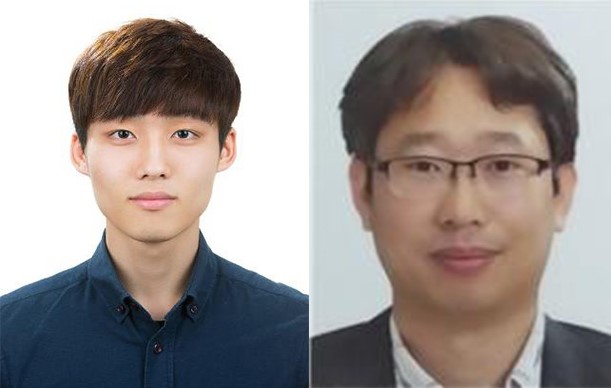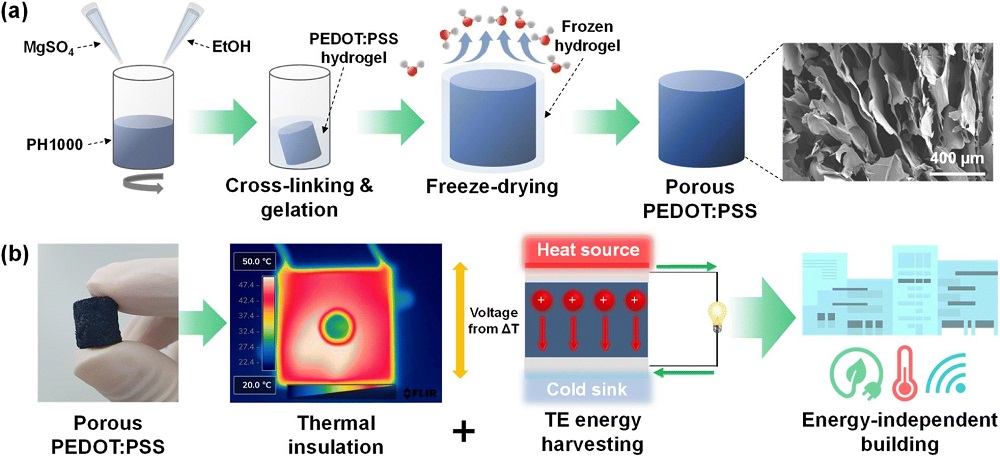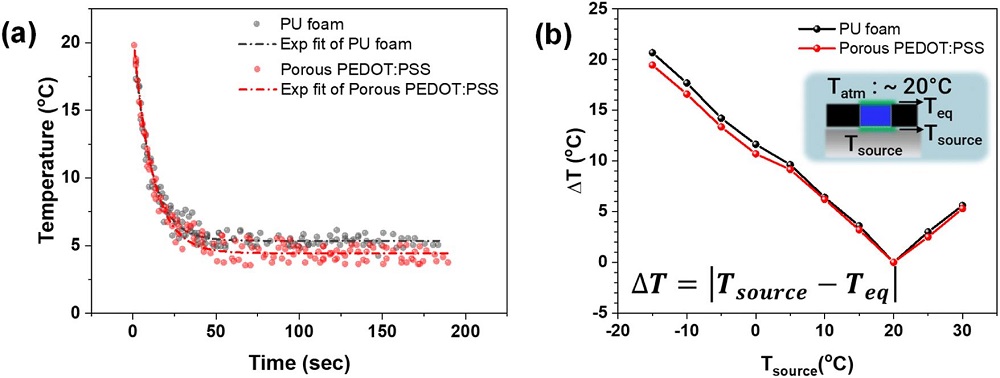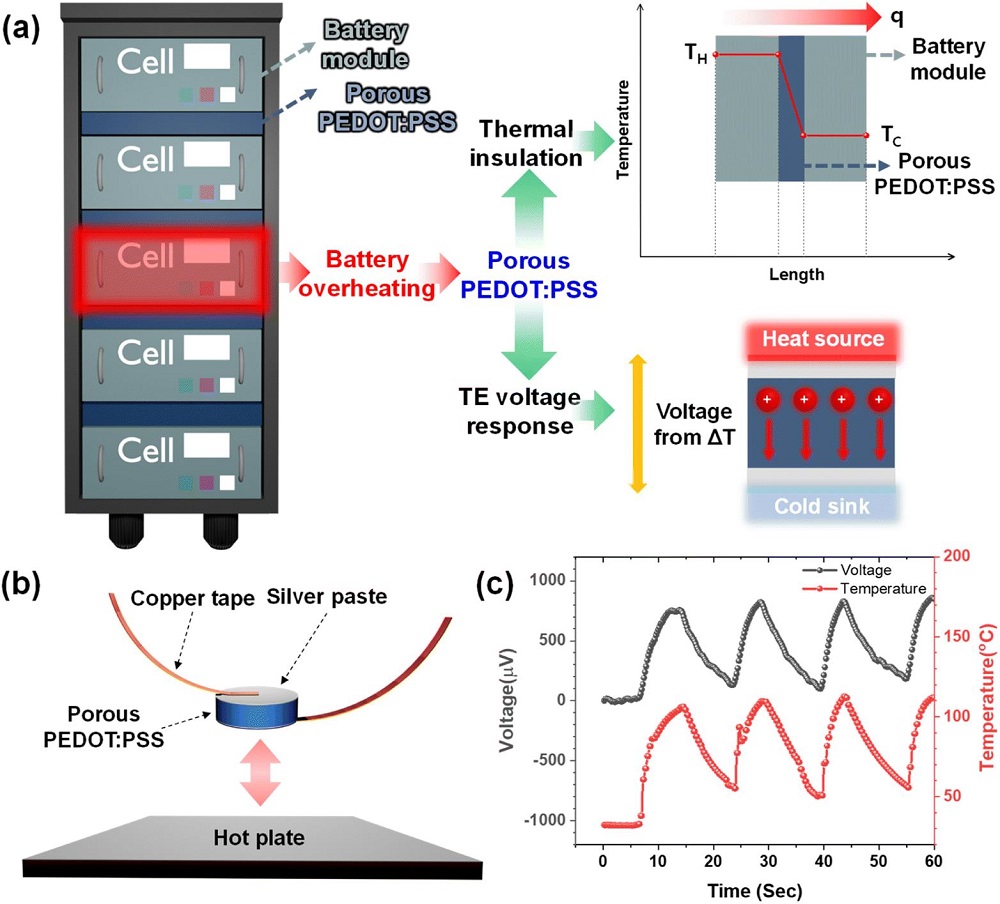Development of Smart Insulating Material for Real-Time Detection of Thermal Runaway in Batteries
A porous smart thermoelectric material was developed to combine insulation, energy harvesting, and heat detection functions.
Professor Im Sang-hyuk’s group published the report in Journal of Materials Chemistry A.

▲ (Left) Yun Jeong-seob (Doctor student, first author) and Professor Im Sang-hyuk (corresponding author) of the Department of Chemical and Biological Engineering.
Professor Im Sang-hyuk’s group of the Department of Chemical and Biological Engineering developed a porous thermoelectric material featuring excellent insulation performance combined with energy harvesting and heat detection functions, suggesting a new approach for responding to the thermal runaway phenomenon in batteries.
The results were officially published in Vol. 13 of Journal of Materials Chemistry A (IF:11.9), an international journal in the field of materials science and energy, on April 7.
* Title of article : Porous PEDOT: PSS smart thermal insulators enabling energy harvesting and detection
*Author information: Yun Jeong-seob (Doctor student, first author) and Professor Im Sang-hyuk (corresponding author).
Considering the annual greenhouse gas emissions of Korea, a plan for developing new energy sources is required to increase the energy independence of the building sector. Meanwhile, with the increasing demand for electric power and the spread of electric vehicles, the thermal runaway of lithium-ion batteries and the resulting fire risk are emerging as serious social problems.
As a way to solve both problems simultaneously, the research group proposed a smart insulation material that utilizes the thermoelectric phenomenon known as the Seebeck effect. The Seebeck effect is the thermal-electrical energy conversion when a temperature difference occurs in a particular material, and charges spread from the high temperature side to the low temperature side, creating a potential difference. Inspired by this principle, the researchers anticipated that, when thermoelectric properties are granted to existing insulating materials unable to actively produce energy, the large temperature difference resulting from their low thermal conductivity may be used to drive the Seebeck effect, allowing the harvesting of thermal energy in a variety of unexploited situations, including general building insulation materials.
*Thermoelectric phenomenon: The term collectively refers to effects characterized by the interaction between heat and electricity, including the Seebeck effect, Peltier effect, and Thompson effect.
*Energy harvesting: The term refers to a technology for harvesting natural energy sources, such as sunlight and heat, and converting them into electrical energy.
Since battery thermal runaway generates significant heat, thermal runaway propagation may occur, meaning that thermal runway is propagated from the battery cell where the thermal runway initiates to adjacent battery cells. Hence, a failure to respond leads to extended damage. To minimize damage from battery thermal runaway, the research group proposed the application of a smart insulating material with thermoelectric properties. They suggested a strategy in which the occurrence of thermal runaway is delayed as long as possible by minimizing the temperature rise in adjacent cells based on the low thermal conductivity of the insulating material, and an initial response to thermal runaway is simultaneously achieved using the insulating material as a temperature sensor through the Seebeck effect forming an electrical potential difference from the temperature difference.
To develop a smart insulating material with insulation performance comparable to that of existing polyurethane foam and excellent electrical conductivity, the research group added an Mg ion salt and an alcohol solvent to poly(3,4-ethylenedioxythiophene):polystyrene sulfonate (PEDOT:PSS) and formed a hydrogel through heat treatment. The hydrogel was freeze-dried at a low vacuum level of several mbar to prepare porous PEDOT:PSS. Cross-linking of the conductive polymer due to the addition of the Mg ion salt was combined with freeze-drying at the low vacuum level, thereby minimizing the decrease in porosity due to the shrinkage of the polymer network. As a result, the research group developed a thermoelectric material featuring a high porosity of 0.9517 and a low thermal conductivity of 0.041 Wm-1K-1.
Furthermore, the research group demonstrated that the heat energy harvesting performance of the smart insulating material could be improved by increasing its electric conductivity through the phase separation of the non-conductive PSS portion and the conductive PEDOT portion, induced by increasing the amount of alcohol solvent added. The developed smart insulating material exhibited a thermal energy harvesting performance of 90.2 nWcm-2, while stably maintaining a temperature difference of 15.16 K, and it also showed excellent temperature sensing performance by quickly responding to external temperature changes.
Professor Im explained the significance of the research, saying “Our research established a novel approach to solving major social and environment problems in the energy industry by combining an insulating material with thermoelectric phenomena.”
This study was supported by the National Research Foundation of Korea (NRF) under the Ministry of Science, ICT & Future Planning.
<Figure 1>

▲ Schematic diagram of manufacturing the porous PEDOT:PSS-based smart insulating material.
<Figure 2>

▲ Insulation performance of the porous PEDOT:PSS.
(a). Process of reaching a thermal equilibrium in the porous PEDOT:PSS and the existing polyurethane foam.
(b). Temperature differences at a thermal equilibrium depending on the source temperature of the porous PEDOT:PSS and the existing polyurethane foam.
<Figure 3>

▲ Thermal energy harvesting performance of the porous PEDOT:PSS.
(a). Thermal energy harvesting performance of the porous PEDOT:PSS depending on the source temperature.
(b). Thermal energy harvesting performance of the porous PEDOT:PSS depending on the amount of alcohol solvent added.
<Figure 4>

▲ Detection of battery thermal runaway using the porous PEDOT:PSS-based smart insulating material.
(a). Schematic diagram explaining the principle of battery thermal runaway detection using the porous PEDOT:PSS.
(b). Schematic diagram of the evaluation of the temperature detection performance of the porous PEDOT:PSS.
(c). Formation of a Seebeck voltage depending on the temperature change of the porous PEDOT:PSS.



